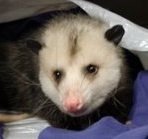The big word of the month is neoteny. Neoteny is a term from developmental biology that refers to the retention of juvenile traits into adulthood. Humans display neoteny compared to our living primate relatives like chimpanzees. Our heads remain relatively large throughout our lives, for instance.
I was inspired to write about this issue by the response to our new baby opossums living in Carolina Wildlife. I think everyone that sees them usually utters the word “cute” within 30 seconds. What makes so many people think baby opossums are cute when so many find the adults unattractive? Look at the two pictures below, which one is cuter?


If you had a preference it was probably for the second photo (unless you are our volunteer Annie, then you like them all!). The first is a perfectly handsome adult opossum, the second is one of our new baby marsupials. Like most young mammals, opossums have large eyes and ears as well as shorter noses than adults of the species.
 This pattern of facial features in baby humans seems to trigger the “cuteness” centers in our brains. The response is thought to be adaptive since it makes us more likely to take care of offspring. But the “cute center” in our brain is not very specific, it responds to almost any animal with the correct features. Most of the animals we think of as cute have large eyes and bigger heads and ears. Koalas, panda bears, and domestic dogs and cats all follow the cute pattern.
This pattern of facial features in baby humans seems to trigger the “cuteness” centers in our brains. The response is thought to be adaptive since it makes us more likely to take care of offspring. But the “cute center” in our brain is not very specific, it responds to almost any animal with the correct features. Most of the animals we think of as cute have large eyes and bigger heads and ears. Koalas, panda bears, and domestic dogs and cats all follow the cute pattern.
Advertisers and entertainers know this too. Disney took an animal that horrifies people when found in their home and turned it into a billion dollar enterprise.
Read more about the science of cuteness in this article from the New York Times.
Opossum photos from the MLS animal department blog
Human head comparison from Wikimedia commons